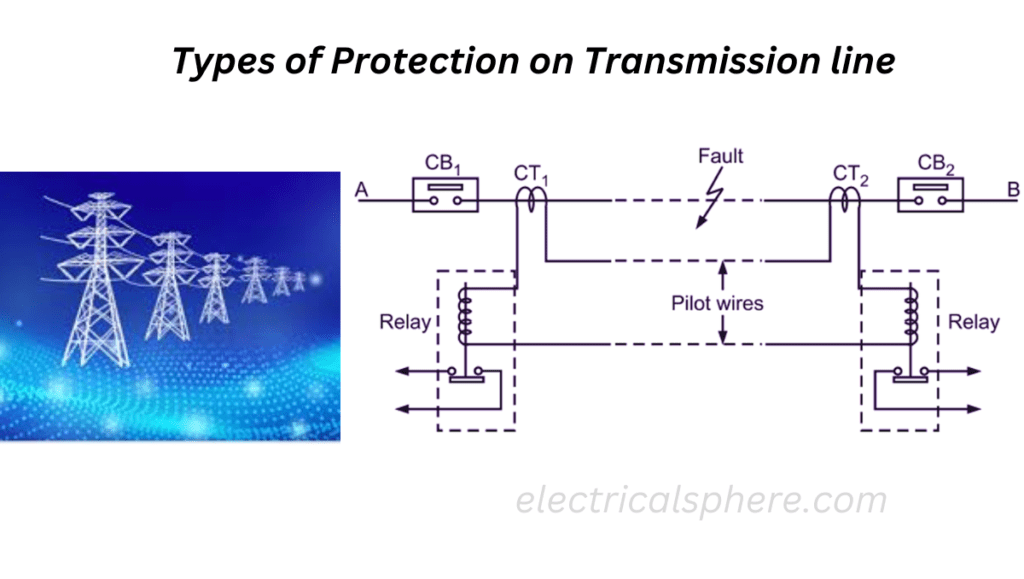
Table of Contents
ToggleTypes of Protection on Transmission line
Line protection is achieved by following protection system:
Distance Protection
Over current and Earth fault protection.
LBB Protection.
Over voltage protection.
In 400/220/132 KV line, all above protection are provided.
In 400KVlines, 2 distance protection schemes termed as main 1 and main 2 protections are provided.
In 220/132KV system for Main 1 Protection, distant protection scheme is provided and other protection is back up protection which is directional over current and earth fault.
In 66 KV system, Dir./Non dir Over current and Earth fault protection is provided.
Distance Protection
This is under impedance protection, setting of which are calculated on the basis of positive and zero sequence impedance of line be protected which varies linearly with the distance of the line and hence it is called distance protection.
Generally line to be protected should trip in the shortest possible time (instantaneously) but if fault is within the full length of line i.e. in the adjoining section and if it is not cleared by the relays of faulty section, line is to trip after some delay to stop feeding faulty section. Distance protection is therefore divided into 3 zones to take care of such eventuality. These zones are termed as Zone-1, Zone-2 and Zone-3.
Zone -1 covers 80% of the line length and gives instantaneous tripping to the line. 80% distance is selected in order to take care of CT/PT error and relay accuracy etc. in order to prevent overreaching of the protection. For balance 20% carrier aided protection is incorporated to prevent instant tripping.
Zone-2 protection covers 120% of the line and gives delay tripping if the fault is beyond the line & within 20% of the line impedance at the opposite end.
Zone -3 covers the full length of line as well as 90%of longest line at opposite end of the line and gives delayed tripping of the line and if the fault continuous to persist even after elapse of zone 2 time.
Carrier aided protection scheme
Carrier aided protection scheme is introduced in distant protection for achieving instantaneous tripping of the line if the fault is between 80 to 100%of the line and which is not covered by zone-1 settings. There are mainly 3 types of carrier protection scheme.
- Permissive under reach : In this scheme, carrier signal is transmitted to the opposite end when fault is sensed by DPR in zone 1. The opposite end on receipt of signal, trip instantaneously if it senses fault in zone 2.
- Permissive over reach scheme: In this scheme DPR send carrier signal to opposite end if it senses fault up to zone-2 measurement. The relay on the other end trips if it senses fault within zone 2 measurement.
- Carrier blocking scheme : In this scheme DPS send carrier to the opposite end if it senses fault in reverse direction. The relay on the opposite end blocks the tripping till zone 2 time if it receives signal. If it does not receive any signal, it trips the line on the end of 80/100 msec. set on the relay as waiting time.
In 400 KV lines Main 1 protection generally employ permissible under reach scheme and main 2, permissive over reach scheme. In some 400KV lines, earlier carrier blocking scheme were provided, but owing to unsatisfactory performance, the schemes are being modified/replaced by permissive over reach scheme.
Other Protection with distance protection relays
SOTF : If the line is switched on a permanent fault on the line, this feature instantaneously trip the line if the fault is any where on the line.
Fuse failure : If any of the PT fuse fails, the distant protection scheme block the tripping and give an audible alarm.
Power Swing : If power swing develops on the line, distance protection scheme gives audible alarm and if swing persists, it gives tripping command after set time limit usually 2 secs.
Fault locator and disturbance recorder : The fault locators calculate the distance to the fault and gives display. The disturbance recorder produces oscillographic analog signals like voltage and current as well digital signal and gives the record in predesignated format.
Over voltage protection
There are 2 stages of over voltage protection. Stage -1 is set at 110% with time delay and stage 2 is set at 150% instantaneous. This is to prevent over stressing of the transmission elements like line insulators, CTs, Bushings, circuit breakers etc.
LBB Protection
If while clearing fault, the breaker gets struck up, the fault current continues to be fed. In such cases, at set time delay of 200msec, LBB protection operates and all the breakers of the affected bus are tripped.
Autoreclosure
Most of the single phase faults on line are of transient nature. In such cases, auto reclosure operates and after certain time delay (1 Sec), it gives closing command to the breaker. If the fault is of transient nature and is cleared, the line remains in service after reclosing of the breaker. If fault is of permanent nature, all the 3 poles of the breaker trips.
220kV and 66kV Transmission line protection
220/132 KV Line :
In 220/132 kV line, the distant protection is provided as above as main 1 protection & over current and Earth fault as back up protection Back up protection operates if main 1 protection fails to operate due to any reason and isolate the faulty line after some delay typically 250-300msecs.LBB Protection is same as above.
66 KV line :
In 66 KV system, 2/3 element over current and one earth fault protection either directional or non-directional depending upon whether the feeder is part of a ring feeders or is radial. LBB and any other protection is not provided in 66 KV system.


Pingback: What is Distance Protection Relay - Electricalsphere
Enjoyed reading this, very good stuff, thanks.